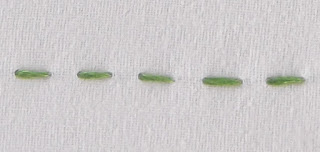The running
stitch or straight stitch is probably the simpest stitch in embroidery. The
stitch is worked by passing the needle in and out of the fabric. The result
resembles a dashed line. Running stitches may be of varying length. In some
cases it is preferable both the lines and the spaces to have equal length. In
other cases, it is more convenient the lines to be longer that the spaces and more
thread to be visible on the top of the fabric that in the underside. The running
stitch can be worked in straight or curved lines. It is also the basic stitch in Sashiko embroidery.
Watch the video
Instructions:
1. Insert the needle into the fabric through point (1) from the back side and pull it until the knot reaches the fabric.
2. Leave a small space from the previous spot, poke the needle into the fabric and pull it through point (2) to the back.
2. Leave a small space from the previous spot, poke the needle into the fabric and pull it through point (2) to the back.
3. Leave a small space on the back of the fabric, poke the needle into the fabric and pull through point (3) to the front.
4. Leave a small space from the previous spot and pass the needle to the back through point (4).
4. Leave a small space from the previous spot and pass the needle to the back through point (4).
5. Continue working in the same manner, trying to keep the same spaces between lines. Also the sittches should have the same length.
Note: Instead of making the standard up and down movement, you can make several stitches at once by folding the fabric. The first method is called stab stitch and usually requires a hoop or frame.With this method you place one stitch at a time. The second method is called sewing stitch and it is worked with shallow stitches without a hoop.
Note: If you are right handed, stitch from right to left and if you are left handed stitch from left to right.
Note: Instead of making the standard up and down movement, you can make several stitches at once by folding the fabric. The first method is called stab stitch and usually requires a hoop or frame.With this method you place one stitch at a time. The second method is called sewing stitch and it is worked with shallow stitches without a hoop.
Note: If you are right handed, stitch from right to left and if you are left handed stitch from left to right.
Watch the video
Embroidery samples with running stitch
 |
| White thread on blue, cotton fabric |
 |
| Hand embroidered work with several stitches |
 |
| Detail of a larger painting with running stitches. |





No comments:
Post a Comment